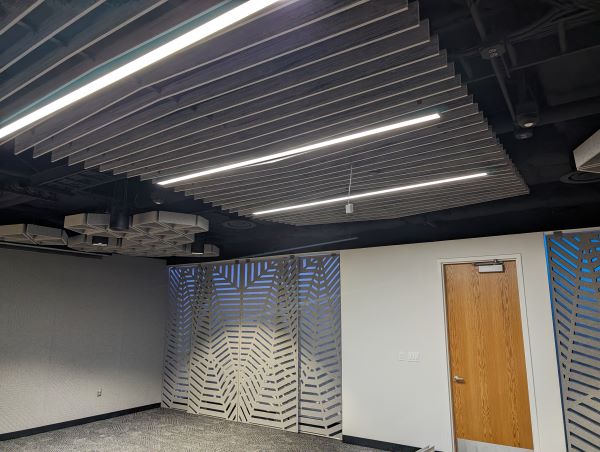Specialty ceilings are when acoustics and aesthetics are blended together to create a beautiful soundscape. While there are traditional forms of acoustic treatment like acoustic ceiling tile, there are also decorative forms that elevate a space. This creates a sophisticated environment where noise is treated without the loss of aesthetics. There are many kinds of specialty ceilings which we will review below.
Types of Specialty Ceilings
There are several kinds of specialty ceilings. This includes acoustic ceiling baffles, clouds, metal, wood, decorative gypsum, etc. Acoustic ceiling baffles are suspended vertically from the ceiling and are made from materials like recycled polyester, fiberglass, or foam that absorb sound energy and reduce reverberation time. Because they hang vertically, baffles are highly effective in large, open areas with limited wall space. They’re especially useful in spaces where traditional wall panels might not be feasible. Acoustic ceiling clouds are very similar; they are panels that lay horizontally on the ceiling. They are available in a variety of shapes (squares, circles, rectangles, hexagons), sizes, and finishes (fabric-wrapped, painted, perforated), clouds can serve as both an acoustic solution and a design centerpiece.

Metal ceilings are unique. The acoustic performance of metal ceilings comes from precision-perforated panels. These perforations allow sound waves to pass through the metal and be absorbed by an acoustical backing material—typically mineral wool or fiberglass. Wood ceilings on the other hand, come in many forms: linear wood slats, wood grille panels, or perforated wood tiles. Each configuration offers different visual and acoustic characteristics, allowing for tailored design solutions.
Decorative gypsum ceilings are ceiling designs made using gypsum boards or panels that are both functional and visually appealing. Gypsum, a soft sulfate mineral, is widely used in interior design due to its versatility, smooth finish, and ease of customization. Gypsum allows for intricate detailing and patterns such as floral motifs, geometric designs, medallions, cornices, and layered tray ceilings. This aesthetic form of acoustic treatment has guaranteed results that transforms an environment.

Specialty Ceilings: Conclusion
In conclusion, specialty ceilings offer a dynamic blend of functionality and design, elevating the aesthetics and performance of interior spaces. Whether it’s the acoustic control of ceiling baffles and clouds, the natural warmth of wood finishes, the sleek durability of metal panels, or the artistic expression found in decorative gypsum ceilings, each system serves a distinct purpose while contributing to the overall ambiance. By selecting the right specialty ceiling, designers and facility managers can enhance sound quality, conceal mechanical systems, support lighting and HVAC integration, and reinforce a space’s architectural identity.

